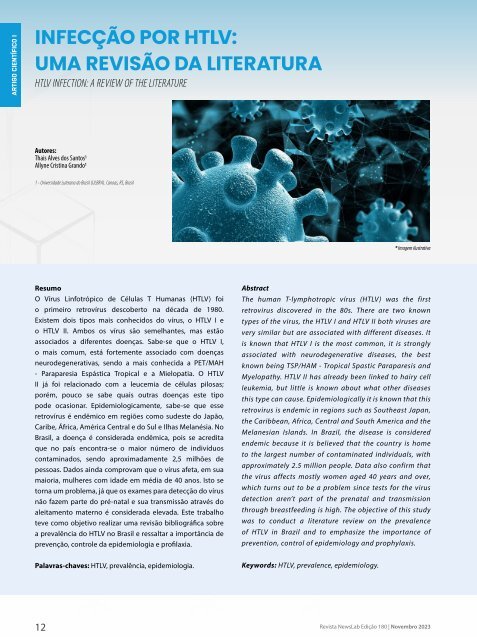Revista Newslab edição 180
Revista Newslab edição 180
Revista Newslab edição 180
Create successful ePaper yourself
Turn your PDF publications into a flip-book with our unique Google optimized e-Paper software.
ARTIGO CIENTÍFICO I<br />
INFECÇÃO POR HTLV:<br />
UMA REVISÃO DA LITERATURA<br />
HTLV INFECTION: A REVIEW OF THE LITERATURE<br />
Autores:<br />
Thais Alves dos Santos1<br />
Allyne Cristina Grando1<br />
1 - Universidade Luterana do Brasil (ULBRA). Canoas, RS, Brasil<br />
* Imagem ilustrativa<br />
Resumo<br />
O Vírus Linfotrópico de Células T Humanas (HTLV) foi<br />
o primeiro retrovírus descoberto na década de 1980.<br />
Existem dois tipos mais conhecidos do vírus, o HTLV I e<br />
o HTLV II. Ambos os vírus são semelhantes, mas estão<br />
associados a diferentes doenças. Sabe-se que o HTLV I,<br />
o mais comum, está fortemente associado com doenças<br />
neurodegenerativas, sendo a mais conhecida a PET/MAH<br />
- Paraparesia Espástica Tropical e a Mielopatia. O HTLV<br />
II já foi relacionado com a leucemia de células pilosas;<br />
porém, pouco se sabe quais outras doenças este tipo<br />
pode ocasionar. Epidemiologicamente, sabe-se que esse<br />
retrovírus é endêmico em regiões como sudeste do Japão,<br />
Caribe, África, América Central e do Sul e Ilhas Melanésia. No<br />
Brasil, a doença é considerada endêmica, pois se acredita<br />
que no país encontra-se o maior número de indivíduos<br />
contaminados, sendo aproximadamente 2,5 milhões de<br />
pessoas. Dados ainda comprovam que o vírus afeta, em sua<br />
maioria, mulheres com idade em média de 40 anos. Isto se<br />
torna um problema, já que os exames para detecção do vírus<br />
não fazem parte do pré-natal e sua transmissão através do<br />
aleitamento materno é considerada elevada. Este trabalho<br />
teve como objetivo realizar uma revisão bibliográfica sobre<br />
a prevalência do HTLV no Brasil e ressaltar a importância de<br />
prevenção, controle da epidemiologia e profilaxia.<br />
Palavras-chaves: HTLV, prevalência, epidemiologia.<br />
Abstract<br />
The human T-lymphotropic vírus (HTLV) was the first<br />
retrovirus discovered in the 80s. There are two known<br />
types of the virus, the HTLV I and HTLV II both viruses are<br />
very similar but are associated with different diseases. It<br />
is known that HTLV I is the most common, it is strongly<br />
associated with neurodegenerative diseases, the best<br />
known being TSP/HAM - Tropical Spastic Paraparesis and<br />
Myelopathy. HTLV II has already been linked to hairy cell<br />
leukemia, but little is known about what other diseases<br />
this type can cause. Epidemiologically it is known that this<br />
retrovirus is endemic in regions such as Southeast Japan,<br />
the Caribbean, Africa, Central and South America and the<br />
Melanesian Islands. In Brazil, the disease is considered<br />
endemic because it is believed that the country is home<br />
to the largest number of contaminated individuals, with<br />
approximately 2.5 million people. Data also confirm that<br />
the virus affects mostly women aged 40 years and over,<br />
which turns out to be a problem since tests for the virus<br />
detection aren’t part of the prenatal and transmission<br />
through breastfeeding is high. The objective of this study<br />
was to conduct a literature review on the prevalence<br />
of HTLV in Brazil and to emphasize the importance of<br />
prevention, control of epidemiology and prophylaxis.<br />
Keywords: HTLV, prevalence, epidemiology.<br />
12 <strong>Revista</strong> NewsLab Edição <strong>180</strong> | Novembro 2023

















